The pool pump is literally the heart of your pool’s circulation system. But just like our own hearts, we have a tendency to neglect the health and well-being of the pool pump and then freak out when it’s not working properly. There are probably dozens of pool pump mistakes out there. . . here are our top 5.
Not Cleaning Pump Basket
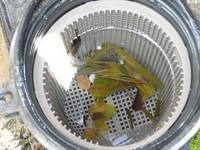 Let’s start with the very basics. The pump strainer basket exists to catch debris but it can’t clean itself. You need to reach in there and get the gunk out. If you don’t, the pool will have decreased water flow which means reduced filtration and ultimately, the dreaded algae bloom. The pump basket should be cleared out weekly and even more frequently during the fall and spring when there is more debris in the pool. Learn more here about how to clean your pump strainer basket.
Let’s start with the very basics. The pump strainer basket exists to catch debris but it can’t clean itself. You need to reach in there and get the gunk out. If you don’t, the pool will have decreased water flow which means reduced filtration and ultimately, the dreaded algae bloom. The pump basket should be cleared out weekly and even more frequently during the fall and spring when there is more debris in the pool. Learn more here about how to clean your pump strainer basket.
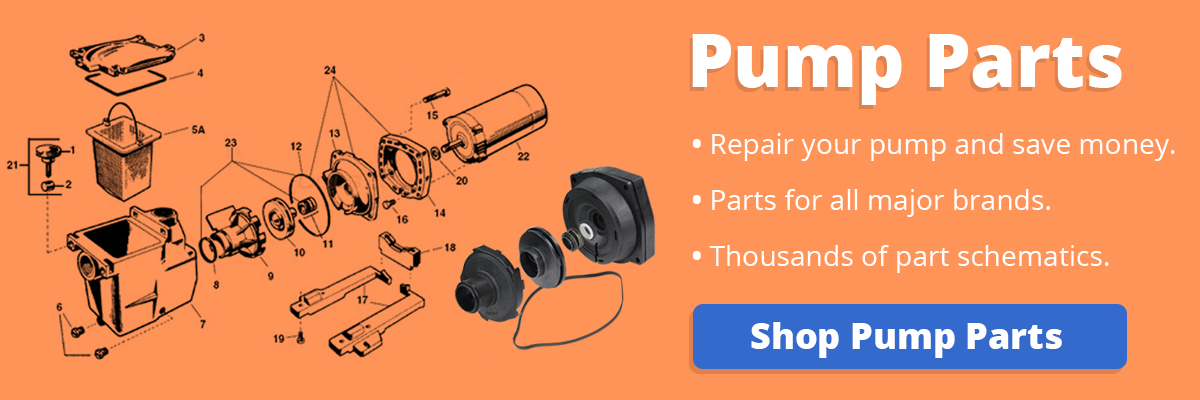
Running Pump Too Little or Too Much
Some pool owners, desperate to save money on their electric bills, actually cost themselves more in the long run by not running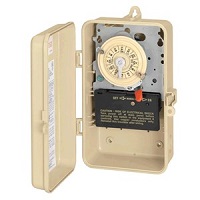 the pump long enough. To maintain water quality and safety, all of the water in your pool should be turned over (meaning filtered) once a day. Depending on the gallons per minute your pump is moving, this usually takes 8 – 12 hours. If you don’t give all the water a chance to pass through the filter, you can end up with dirty, cloudy water, algae and the need to spend more on chemicals and maintenance than you would’ve given to your utility company to run the pump a little longer.
the pump long enough. To maintain water quality and safety, all of the water in your pool should be turned over (meaning filtered) once a day. Depending on the gallons per minute your pump is moving, this usually takes 8 – 12 hours. If you don’t give all the water a chance to pass through the filter, you can end up with dirty, cloudy water, algae and the need to spend more on chemicals and maintenance than you would’ve given to your utility company to run the pump a little longer.
On the flip side, there is running the pump too long. Some believe in keeping it going 24/7 which might be necessary under certain conditions but for most pools is just wasteful overkill. It drains both energy and money while causing unnecessary strain on the pool pump motor. Your pump will burn out more quickly and require replacement of parts or the entire unit. Plus, you are driving your neighbors crazy! Give them a break from that humming motor and save some money in the process. For standard residential pools with moderate use, you only need to turn over all the water once in a 24 hour time period. If you are into the math behind pump run times and savings, read our How to Reduce Your Pool Pump Energy Bill guide.
Sizing Pump Incorrectly
There is a very persistent myth in the pool world that the higher the horsepower, the better. As a result, it is probably safe to say that the majority of pools have oversized pumps. We regularly hear from customers with a relatively small pool (~ 10,000 gallons) and a pump that is moving 2 – 3 times the gallons per minute required. This means unnecessarily high electric bills and a lot of wasted energy. Too large of a pump can cause poor filter performance and even damage it, if the filter is not also oversized accordingly. Another possible consequence is pump cavitation in which bubbles form in the water inside the pump and then burst with great force, resulting in damage to the impeller and other internal parts.
Conversely, some pool owners try to save a few bucks by buying a lower horsepower pump that is too small for their pool’s demands. This is especially true when a spa and other water features, such as deck jets or waterfalls, are tied into the pool pump. Throw an automatic suction cleaner into the mix and that undersized pump is overloaded.
The bottom line? Do the math to calculate how many gallons are in your pool (and spa if applicable) and how many gallons per minute are required to filter all of that water in 8 – 12 hours. Then consult the manufacturer’s pump performance charts to determine what pump actually meets your needs. Or skip all that, contact us and we’ll do the legwork for you!
Not Priming Pump / Running Dry
Most in-ground pool pumps are self-priming but do not mistakenly think this means your pump can initially prime itself. “Self-priming” refers to the pump being able to reprime, and this depends upon a proper initial prime and maintenance. Priming a pump means filling the intake with water. Then upon start, the pump will push any air out through the discharge. Read our step-by-step priming guide for all the details.
A loss of prime will cause the pump to run dry which you never want to do. Keeping an eye on the pool water level is a must – don’t let it drop below the skimmer opening. If the pump has no water to pull from the skimmer, it will draw air instead and lose prime which leads to running dry. At the least, this will ruin the motor shaft seal which is what prevents water from getting inside the motor. If it keeps running dry, the pump heats up and so does the water inside. Commence melting plastic. The motor might survive due to the high temp sensor kicking in but the wet end of the pump will be a casualty. If your pump has run dry and appears to have survived, replace the shaft seal!
Not Changing the Shaft Seal During Motor Replacement
 I literally grind my teeth over this one. Replacement pool pump motors are an extremely popular product for us – and with good reason. In the majority of cases, when a pump fails, the wet end is fine and only the motor needs to be replaced. Since a pump motor is roughly half the price of a new pump, it makes often sense to keep the existing wet end and just buy a new motor. Especially true for DIYers who don’t have to pay an installer.
I literally grind my teeth over this one. Replacement pool pump motors are an extremely popular product for us – and with good reason. In the majority of cases, when a pump fails, the wet end is fine and only the motor needs to be replaced. Since a pump motor is roughly half the price of a new pump, it makes often sense to keep the existing wet end and just buy a new motor. Especially true for DIYers who don’t have to pay an installer.
But so many people buy just the motor and neglect the small yet extremely important shaft seal. This seal keeps water out of the motor (water inside motor + time = failed motor). Yes, your existing motor will already have a seal on the shaft and it might appear to be in good shape and ok to reuse. However, shaft seals warp over time. If you install the old seal on a new motor, there is a good chance it will not mate properly, leading to leakage which voids the warranty on the new motor.
So don’t skip the new shaft seal! Depending on the pump model, you’re looking at about $15 – $30 to protect a new motor that is worth much more than that. Invest those few extra bucks – you will not regret it. While you’re at it, motor replacement is a great opportunity to upgrade other internal parts most likely to fail. Check for our complete tune up kits, available for many of the most common pool pumps. These include the shaft seal, along with o-rings, gaskets and lubricant. For help with replacing the seal, check out our how to guide and video.


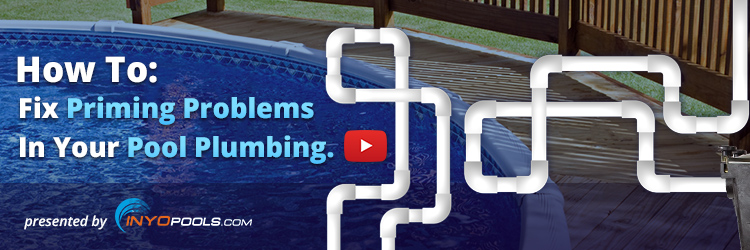
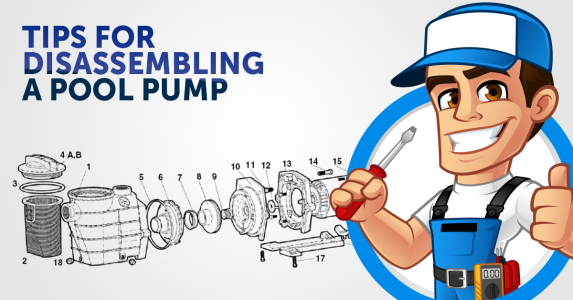
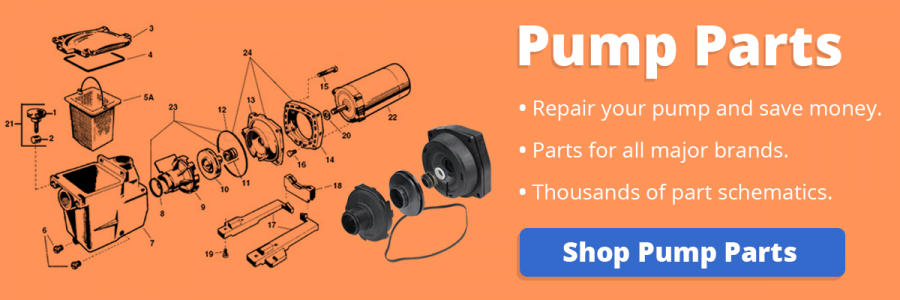
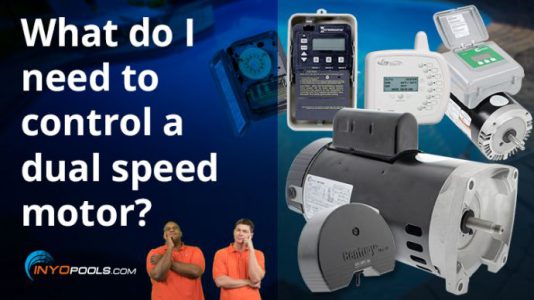






I just had a new motor installed on my hayward pump by my pool guy. Long story short is he didn’t do this and lied about it. I took the motor off and replaced everything according to some youtube videos I watched. The only problem is now the motor won’t start. I think it could be one of two things. 1st is that I may have installed the spring part of the shaft seal backwards. There was a little water in the back electrical compartment where you connect all the wires. The other thing is that it could be the capacitor. One video said to touch a screwdriver onto the 2 connectors to short it out as it retains power.
Your guide said water + time in the motor = failure and in my situation, there would have only been water for a short amount of time. I’m not getting anything when I turn on the power though and it is getting power b/c my other pumps work.
Please advise and thank you so much!
To clarify he didn’t do the shaft seal.
Since it could be a few things, on the motor and inside the pump, I would just start over: remove the motor, check that the seal is properly installed, then require the motor as illustrated on the wiring diagram sticker on the motor. Also installing the shaft seal backward would not prevent the motor from turning, but it would cause a leak.
I am in the process of having my pool resurfaced by a regional chain pool company. They were supposed to let us know when they would be coming so that we would be prepared, but showed up unannounced while we were at work yesterday and drained the pool. The pump and booster are on automatic timers and turned on with an empty pool and ran dry for almost 4 hours before I got home and noticed them running and shut them off. The pool pump is 7 months old, the booster pump is 1 week old. I contacted our sales contact with the pool company to bring the issue to their attention and come up with a plan to make sure everything is functioning right when we start it up again, he said “It takes more than running dry for 4 hours to damage these pumps, there isn’t anything to worry about.” Your article says that running dry is not good, but doesn’t say how long they would have to run dry to cause any damage. Both pump motors were too hot to touch when I turned them off. Should I be concerned in this situation, or is 4 hours of dry running not enough to cause any damage?
A pump running dry for longer than fifteen minutes can damage the pump, melt plastic components, overstress the motor and ruin the shaft seal. I’d have a serious conversation with that sales rep, and have them deal with it seriously by replacing the necessary parts for free or replacing the whole pump.
If they ask to inspect the pump, try to be onsite so you can see it yourself when they open it.
I attempted to go that route, they started coming up with additional charges for resurfacing. The response was “I’ve been in this business for long time, so I know what I am talking about. I had pumps running for days without water and nothing was wrong with them. Oh, by the way, for your warranty on your new plaster to be valid, you have to have it professionally brushed and balanced for 5 days after we finish. That is an additional $600. I also just finished inspecting your pool and found some cracks that we didn’t notice before, they will have to be repaired for an additional cost.”
Information below to help others avoid a mistake that we made:
Our neighbors are also in the process of having their pool resurfaced, so we knew to ask about the cost of aftercare. We were told that this service was included in the price, we failed to get it in writing so they are refusing to honor it. We also discussed some cracks that were obvious below the coping and in a couple of places on the plaster, we were told that they were minor issues that would be easily corrected (epoxied or grouted depending on how wide they are if they are deeper than the plaster) after the old plaster is removed and before the new stuff is installed and that this was also included in the quoted price. Again, we failed to get it in writing and have nothing to stand on. We have paid a 50% non-refundable deposit for this work, the price has now gone up by $600 + whatever the crack repairs end up being, and we have two choices: Pay the additional costs or give the work to someone else and lose the deposit. Lesson: What the salesman says is meaningless, get it all in writing.
Hi Matthew,
Quick question – I have two fountains that run into the pool that are on the same pump. Just the other day, one fountain’s stream became weaker and not as much water was running into the pool, while the other fountain is stronger with more water running into the pool. I didn’t change the valves and since it’s on the same pump, I wouldn’t think there would be a clog. If you have time, let me know your thoughts, thanks!
It depends if the fountain are equal distance from the pump.
If they are – My best guess is that the fountain with the weaker clog has some kind of obstruction in the pipe or nozzle of the fountain. The obstruction is restricting flow to the Fountain B, making water divert to Fountain A causing the stronger flow. Without having eyes on the plumbing that is the only that that can come to mind.
If the stronger fountain is closer to the pump – The pump may have reduced water output, from sucking air leak or a dirty filter. Check for those two problems and check back with us.
Hi, can you please tell me if the filter where all the debris are held has to be turning all the time if the pump is on? I noticed that the pump was going, but the leaves in the container filter is not turning, which means, the water is not recycling. What should I do? I appreciate you help.
Kind regards
Anna
Leafs in the pump strainer basket are not the best telltale on how well a pump is working. You should be able to tell how well a pump is working by your filter’s pressure gauge or by feeling the strength of the return. Your pump’s flow rate may be slowed because you have too many leaves in the basket. Clear out your pump and skimmer strainer baskets and then see how your water flow is.
Hello again all, Ignore my question. I am an idiot. LOL a stick had gotten wedged in the flap that keeps debris from floating back into the pool and the door was stuck up and not allowing enough water in.
Thank you
George
Hello all, I recently replaced my pool motor with the same size that was there. The pump works great when I have the bottom drain or the hot tub set to pull water from. However if I change over to the skimmer it keeps losing the prime because it seems to drain all the water out of the skimmer too fast. The water is at the correct level maybe even a bit above. Any ideas.
Thank you
George
It sounds like water level is low and or main drain is off and all suction is deficated to your skimmer
It was so useful to learn that a pump motor is roughly half the price of a new pump. Our motor has been sitting out all winter, as we forgot to take it out. I see minor cracks in the motor itself. I will be sure to call someone about my options for replacement parts!
I woke up this morning and my inground pool had lost significant water. When I went to work it lost more water, that is usually when the pump runs. I looked at where the water drains from the pump and did not see any wet areas. Any ideas?
The obvious answer, there is a leak in the pool basin or the pipes underground. You will have to get a leak detection company to come out and look at your pool.
Thanks for all the info! My fill line has spring a leak, and the builder would like to cap that line off and run a new line that would flow into and fill from the pump / filter equipment. I want to know if that’s a good idea, bad idea, or makes no difference. He said he does it all the time, and would install with special valves to prevent the fresh water and pump water from backing into each other.
It’s hard to say, because I can’t see the health of the old pipe, the size of the leak or how easy an installation would be. I would get a second opinion from a local different pool guy/contractor to be on the safe side.
Matthew,
Yes, that’s the one!
Thank you!!
Rick
Hi Matthew,
Thanks for responding. The tag on the pump says “Century Centurion” A.O. SMITH
Part 7-177474-01 switch less motor. Then there is a tag that says Model Number 38448300
Serial number. PF-1-10-F03.
That’s pretty much all the info aside from specs.
I changed the o ring early season and it’s the wrong one, and I have air being pulled in.
I believe the top strainer cover o ring is the culprit.
I appreciate your help.
Thanks,
Rick
Rick – that is all motor info again. The motor label is only going to have motor information. To give you an idea of the two sides of a pump, here is an image:
To find the seals you require, we need the model number off the pump side.
That’s the only sticker on the strainer side?
Model number 38448300
Serial number PF-1-10-F03
The motor has a different part and serial number.
Click the following link and tell me if this is what your pump looks like: American Products Ultra Flo
I have a 12 year old AO Smith century Centurion pump model 38448300, the top lid for the strainer is not sealing, I need the Oring or even the entire lid, does anyone know what the replacement PN would be and where I can find it?
I’m not having any success locating that brand.
Thanks
Rick – to find the correct gasket we will need to know the model number of the pump housing side. The AO Smith info provided above is the motor, which can be fitted to dozens of pumps. Can you find a tag on the pump housing that says “pump model number” or find a part number on the strainer lid, basket or other parts?
i need help, i ran my pump for about 7 hrs on my intex 12x24x52 above ground pool and forgot to open the valve and i was gonna go turn it off and there was water spilling thru a outlet on top of the pump, so i closed the valves and turned off the pump, did i mess it up now with doing that, is it ever gonna work again?
It is hard to tell, you may have blown a gasket which should be an easy fix. Or you may have cracked a part of the plumbing or pump which is more expensive to repair. The only way to know for sure is to find the source of the leak.
Hi, I have a new above ground pool, and I have no idea what I’m doing where chemicals are concerned! I purchased chlorine granules, and the directions read to take the skimmer basket out before slowly pouring the granules into the skimmer. My question is should I put the skimmer basket back in while the pump is running and the granules are dissolving? Or should I leave the basket out while the granules are dissolving? I don’t want to damage the pump. Thanks so much!
Once the granules are added to the skimmer they should be diluted into solution pretty quickly allowing you to pop in the skimmer basket.
A better way to add the granules:
1) Fill a 5-gallon bucket with water
2) Add recommended chlorine dose to bucket, then stir.
3) With the pump running, pour the bucket’s contents as you walk the perimeter of the pool.
When I change filter cartridges I immediately have very strong water flow…but within short period (often little as an hour) the flow drops significantly. Pressure not increasing or very little, i.e. 2 lbs. Ideas??
Thx
Does there appear to be any air in the pump when the water flow plummets?
We bought a de filter and hooked it up after using cartridges for 5 years. Now the pump and filter doesn’t put out enough gpm to run our above ground heater. Any suggestions?
What is the model number for your old and new filters? Also, did you bleed the air from the system after installing the new filter?
We bought a above ground pool and the sand filter sprung a leak in the middle of the tank. It was a 150lb doughboy I seen a used filter on Craig’s list that was 250lbs crystal flo2. Not knowing any better I hooked it up to the existing pump and was on my way. We started noticing sand in the pool and the pressure on the tank never went up from 10 lbs even after a month. Pulled sand out to check laterals and they are fine. But I just found out my filter is rated for 60 gpm and the pump is rated for 91. Would this cause sand in pool and what damage might I have done to the filter???
If your pump is pushing 50% more than what your filter is rated for, that is probably the root of the damage. If there was not already damage from it being a used filter in the first place.
If there is sand in your pool, the issue is likely a cracked lateral and/or standpipe. The crack in the equipment may only pop up when the filter is under high pressure, making it hard to find when you are inspecting it by hand.
I accidentally forgot to turn off the pump while cleaning the filter basket and water rushed all over the place. Now my above ground pool will not turn on. Will letting it dry more than likely fix the problem? Thank you.
Yes, I would give the motor some time to dry out before trying it again. Hopefully, there was no internal damage or you will have to replace the motor.
Take a look at this guide for further troubleshooting help: Using the Proper Test Equipment to Troubleshoot Pool Motors
This is Paul again, I forgot to mention the pump is inside a room but it is not heated.
If the pumps are in an equipment room, I would keep the motors on the pumps and save the motor. With the cost of $600, does that include blowing out the lines and other winterization? If not then you are paying a company to essentially remove two motors which is about a half hour worth of work.
For a general idea on how to winterize your pool read this guide, How To Winterize Your In-Ground Pool
Thanks Matthew! We are paying for the company separately to blow out the lines and other winterization, so I think your assessment is correct. I’m anxious to read your guide!
Glad to help!
Good morning. At our community pool, our servicing company recommends pulling the motors (for both baby pool and large pool) for the winter. I’ve read mixed thoughts on the issue. What is your opinion. They are charging $600.
Thanks!
My pump is running, sounds louder than usual, and bounces from 0-10 psi. I am new to pools. Just bought a house with an inground pool. Im clueless! Will running the pump with low pressure cause the pump motor to go out? And, why is my pressure low? Any help or advice is greatly appreciated!! Thanks!
Try cleaning the pool filter
My filter wasn’t working well (I accidentally filled water above skimmer) for a few days. Now that the water level has lowered and the pump is working well again, do I need to let it run longer than usual to make up for the missed days or is it sufficient to run it as normal (does all water once per day). This is an above ground, 10,600 L pool.
Thanks.
Test the water, the results of the test will let you know what needs to be added (if anything.)
Sorry Raypack….
Hi there I have an inground pool with a Hayward pump and daypack heater. I had the pump to half skimmer and half kreepy it didn’t feel like there was any suction but I left it for. 8 hours and when I went to turn to full skimmer I noticed that the pipe coming from the sand filter to heater was very swollen. And the water in the pump basket was steaming. I switched everything off. Is there a blockage or should I be back washing more?
The steaming water and swollen pipe could be caused by low water flow. A pool heater requires a minimum flow rate (depending on model) to keep it from overheating and eventually breaking down. The bulging pipe may be caused by the superheated water deforming the pipe; the steam is likely another symptom of the problem. The heater hi-limit should have stopped the heater from reaching these dangerous levels.
First I would find the reason for the low flow whether it be an air leak or a blockage and then I would get a professional to inspect your heater.
On a separate issue of recent I have encountered an infestation of tiny micro tubular speciem. After shocking pool three times I still have these but it has lessened. How long before you can swim and how do you prevent?
These wiggly tubes, are they maggots?